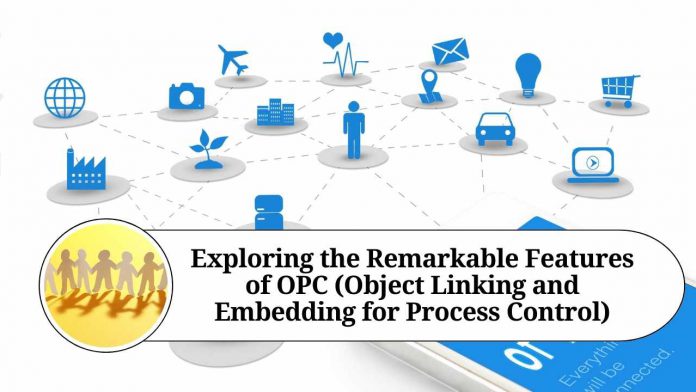Introduction
In the world of industrial automation and process control systems, OPC (Object Linking and Embedding for Process Control) has emerged as a powerful and widely adopted technology. OPC is a standard that enables seamless communication between different devices and software applications, facilitating data exchange, monitoring, and control within industrial environments. In this blog, we will delve into the remarkable features of OPC and understand why it has become an integral part of modern industrial systems.
- Interoperability: One of the key features of OPC is its ability to provide interoperability across diverse hardware and software platforms. OPC acts as a universal interface, allowing various devices, sensors, and software applications to communicate and exchange data in a standardized manner. This interoperability eliminates the need for custom drivers and protocols, enabling easy integration of new devices into existing systems and promoting seamless collaboration among different vendors’ products.
- Scalability: OPC supports both small-scale and large-scale industrial systems, offering excellent scalability. Whether it’s a small factory or a sprawling industrial complex, OPC can efficiently handle the communication requirements. OPC allows for the easy addition or removal of devices without disrupting the overall system, making it highly flexible and adaptable to changing industrial needs. This scalability empowers businesses to expand their operations without major system overhauls, reducing downtime and minimizing costs.
- Data Access: OPC provides efficient and secure access to real-time and historical data from connected devices and sensors. With OPC, users can read, write, and monitor data variables in a consistent and standardized manner, regardless of the underlying hardware or software protocols. This feature facilitates real-time monitoring, data analysis, and decision-making processes, enabling operators to optimize production, troubleshoot issues, and improve overall system performance.
- Redundancy and Fault Tolerance: Reliability is of utmost importance in industrial systems, and OPC addresses this by offering redundancy and fault tolerance features. OPC supports redundant data servers and network configurations, ensuring uninterrupted data flow even in the event of hardware failures or network disruptions. Redundancy eliminates single points of failure and enhances system resilience, guaranteeing continuous operations and preventing costly downtime.
- Security: OPC incorporates robust security measures to protect sensitive data and prevent unauthorized access. It employs industry-standard encryption protocols and authentication mechanisms to ensure secure communication between devices and software applications. OPC’s security features safeguard critical information, such as process parameters, production data, and control commands, from malicious attacks, ensuring the integrity and confidentiality of industrial systems.
- Vendor Neutrality: OPC’s vendor-neutral nature is a significant advantage for industrial systems. It promotes competition and allows businesses to choose the best-in-class devices, sensors, and software applications from different vendors without worrying about compatibility issues. OPC’s vendor neutrality fosters innovation, encourages technological advancements, and gives users the freedom to build customized solutions tailored to their specific requirements.
Conclusion
OPC has revolutionized industrial automation by providing a standardized, interoperable, and scalable communication framework. Its remarkable features, including interoperability, scalability, data access, redundancy, security, and vendor neutrality, make it an indispensable technology in modern industrial systems. As industries continue to evolve and embrace digital transformation, OPC will undoubtedly play a pivotal role in enabling seamless connectivity, data exchange, and efficient control, thereby driving productivity, efficiency, and competitiveness in the industrial landscape.
Other Related Blogs: Section 144B Income Tax Act
Frequently Asked Questions (FAQs)
Q1: What is the main advantage of OPC?
A1: The main advantage of OPC is its ability to provide interoperability, allowing different devices and software applications to communicate and exchange data in a standardized manner. This eliminates the need for custom drivers and protocols, simplifying system integration and promoting seamless collaboration among various vendors’ products.
Q2: How scalable is OPC?
A2: OPC is highly scalable, catering to both small-scale and large-scale industrial systems. It can handle the communication requirements of diverse industrial environments, enabling easy addition or removal of devices without disrupting the overall system. This scalability empowers businesses to expand their operations without major system overhauls, minimizing downtime and costs.
Q3: What types of data can be accessed using OPC?
A3: OPC provides efficient and secure access to real-time and historical data from connected devices and sensors. It enables users to read, write, and monitor data variables consistently across different hardware and software platforms. This data access facilitates real-time monitoring, data analysis, and decision-making processes, contributing to improved system performance.
Q4: How does OPC ensure system reliability?
A4: OPC incorporates redundancy and fault tolerance features to enhance system reliability. It supports redundant data servers and network configurations, ensuring uninterrupted data flow even in the presence of hardware failures or network disruptions. Redundancy eliminates single points of failure, minimizing system downtime and improving overall system resilience.
Q5: How does OPC address security concerns?
A5: OPC prioritizes security and employs industry-standard encryption protocols and authentication mechanisms to ensure secure communication between devices and software applications. It protects sensitive data and prevents unauthorized access, safeguarding critical information such as process parameters, production data, and control commands from malicious attacks.
Q6: Can OPC work with devices and software from different vendors?
A6: Yes, OPC is designed to be vendor-neutral, allowing users to integrate devices, sensors, and software applications from different vendors seamlessly. Its vendor neutrality promotes competition, fosters innovation, and gives users the flexibility to choose the best-in-class solutions that meet their specific requirements without worrying about compatibility issues.
Q7: Does OPC support legacy systems?
A7: Yes, OPC provides backward compatibility, enabling integration with legacy systems. OPC servers can communicate with older devices and software applications, ensuring a smooth transition and protecting previous investments in infrastructure while facilitating modernization and technology upgrades.
Q8: Can OPC handle real-time data exchange?
A8: Absolutely, OPC is capable of handling real-time data exchange. It allows for the timely and efficient exchange of data between devices and software applications, supporting real-time monitoring, control, and decision-making processes in industrial systems.
Q9: Is OPC suitable for specific industries?
A9: OPC is applicable to a wide range of industries, including manufacturing, energy, oil and gas, pharmaceuticals, transportation, and more. Its versatility and flexibility make it a valuable technology for diverse industrial sectors, enabling efficient communication and data exchange across various equipment and systems.
Q10: How can businesses benefit from implementing OPC?
A10: Implementing OPC can provide several benefits to businesses, including improved interoperability, enhanced scalability, efficient data access, increased system reliability, strengthened security measures, and the freedom to choose solutions from different vendors. These benefits contribute to increased productivity, streamlined operations, and optimized performance in industrial processes.




















